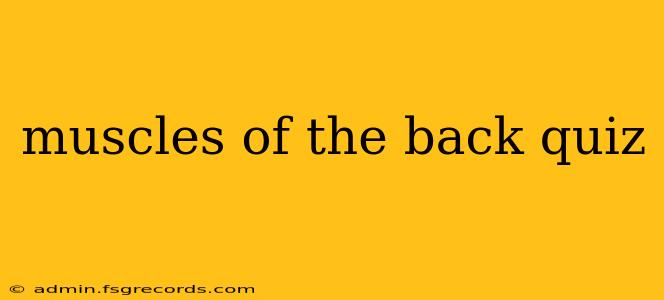Are you a fitness enthusiast, a medical student, or simply someone fascinated by the human body? This quiz will put your knowledge of the back muscles to the test. The intricate network of muscles in your back provides posture, movement, and overall stability. How well do you understand this complex system? Let's find out!
Instructions:
Choose the best answer for each multiple-choice question. At the end, you'll find your score and a brief explanation of the correct answers. Good luck!
Question 1:
Which of the following muscles is NOT a part of the erector spinae group?
a) Spinalis b) Longissimus c) Iliocostalis d) Trapezius
Question 2:
The deepest layer of back muscles primarily functions in:
a) Extending the spine b) Rotating the spine c) Lateral flexion of the spine d) Fine motor control of the spine
Question 3:
Which muscle is responsible for the majority of back extension?
a) Rhomboids b) Latissimus Dorsi c) Erector Spinae d) Quadratus Lumborum
Question 4:
The rhomboid major and minor muscles are primarily responsible for:
a) Rotating the shoulder blades b) Retracting the shoulder blades c) Elevating the shoulder blades d) Both b and c
Question 5:
Which muscle plays a significant role in both respiration and posture?
a) Levator Scapulae b) Serratus Posterior Inferior c) Quadratus Lumborum d) Latissimus Dorsi
Question 6:
The latissimus dorsi muscle is a large superficial muscle that contributes to:
a) Shoulder extension, adduction, and internal rotation b) Shoulder abduction and external rotation c) Hip flexion and extension d) Neck flexion and extension
Question 7:
Which muscle group helps stabilize the shoulder blades and improves posture?
a) Erector Spinae b) Rhomboids and Trapezius c) Latissimus Dorsi d) Quadratus Lumborum
Question 8:
Pain in the lower back is often associated with issues in which muscle group?
a) Rhomboids b) Trapezius c) Erector Spinae d) Levator Scapulae
Answer Key & Explanations:
-
d) Trapezius: The trapezius is a superficial back muscle, not part of the deep erector spinae group.
-
d) Fine motor control of the spine: The deepest layer muscles (transversospinalis group) are responsible for precise movements and stabilization.
-
c) Erector Spinae: The erector spinae group is the primary extensor of the spine.
-
d) Both b and c: The rhomboids retract (draw together) and elevate the shoulder blades.
-
c) Quadratus Lumborum: This muscle aids in respiration by assisting in expanding the rib cage and plays a crucial role in stabilizing the lumbar spine.
-
a) Shoulder extension, adduction, and internal rotation: The latissimus dorsi is a powerful muscle with these primary functions.
-
b) Rhomboids and Trapezius: These muscles work together to stabilize and improve the posture of the shoulder blades.
-
c) Erector Spinae: Problems within the erector spinae muscles are a common cause of lower back pain.
Scoring:
- 7-8 Correct: Excellent! You have a solid understanding of the back muscles.
- 5-6 Correct: Good! You have a decent grasp of the subject; review areas where you struggled.
- 3-4 Correct: Fair. Further study of the back musculature is recommended.
- Below 3 Correct: It's time for a deep dive into back muscle anatomy! Consider using anatomical charts and models for better visualization.
This quiz is intended for educational purposes only and does not constitute medical advice. If you experience back pain, consult a healthcare professional for proper diagnosis and treatment.

